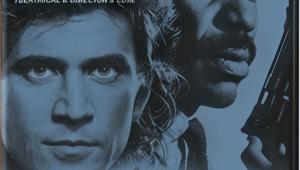Sonos Sub Mini Powered Subwoofer Review

AT A GLANCE
Plus
Most affordable Sonos subwoofer
Compact, attractive
Controlled, restrained bass response
Minus
No Trueplay for Android
Fixed crossover
Only useable in the Sonos ecosystem
THE VERDICT
The Sonos Sub Mini is a great way (albeit, one of only two ways) to add deep bass to a Sonos soundbar or speaker in a small listening room. Considering that Sonos is a closed system, the Sub Mini only works with Sonos products, and Sonos products will only work with Sonos subwoofers. While not exactly a budget item, it's the most affordable subwoofer in the Sonos ecosystem.
What is the number one complaint about almost every soundbar? Let's say it together: lack of deep bass, right? Even soundbars as sonically competent as the Sonos Beam and Ray could benefit from more bass. So, fittingly, Sonos has just released the Sono Sub Mini (MSRP $429), a compact subwoofer that perfectly bonds with all of the non-portable, amplified Sonos products. It should be noted that while the Sub Mini will work with the larger Arc soundbar, Sonos recommends using that configuration only in a smaller room and at low-to-moderate listening levels. Fair enough.
This isn’t the first subwoofer offered by Sonos. The original Sonos Sub is a much larger, heavier, and significantly costlier version, so the Mini is a welcome addition to the ecosystem. It weighs in at 14 lbs. and measures 12” high and 9.1” wide. Granted, the Sub Mini costs as much as, if not more than, some of the Sonos soundbars themselves. But it is worth the price to get the deep bass most of them lack.
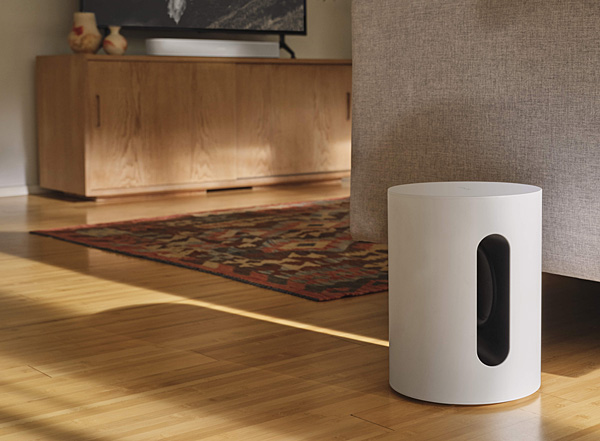
The Sub Mini is a compact, wireless subwoofer, though it is amplified, so it needs an AC connection. It connects to your other Sonos products through a 5 GHz WiFi signal for low latency and better lip-sync performance. The bottom of the sub has a power connection and an Ethernet port. There are four rubberized feet that raise it high enough for easy cable routing, and the feet protect floor surfaces and prevent any vibration or resonances from below. Available in matte black or white, the sealed cylindrical cabinet has a single pairing button on the side and an NFC area on the top for use while setting up. The cabinet houses two inward-facing 6-inch woofers. This design is said to cancel distortion and boost performance. (The original Sonos Sub uses a similar configuration, so there’s proof of concept.) The Sub Mini frequency response extends to 25 Hz.
The woofers are powered by a pair of Class-D amplifiers. Also similar to the Sonos Sub, the Mini has an oval opening between the two woofers that is designed to help move air more efficiently to maximize bass performance and reduce vibrations. Your neighbors will appreciate that. Unlike the original Sub, the Sub Mini can only be used upright. However, its slim footprint and attractive design make it easy to find a nice place for it in almost any decor. Only one Sub Mini can be used at a time; you cannot bond two in a system.
As with most Sonos products, all controls are done via the Sonos app. Trueplay automatic tuning calibration is supported, but still only on certain iOS products. (Dear Sonos, please work on getting Trueplay for Android products. This great technology needs to be enjoyed by everyone. Sincerely, the 70% of the world using Android.) The EQ and crossover are automatically adjusted based on which Sonos product the Mini is bonded with. Yes, Sonos products don’t just pair, they “bond.” The bass level is controlled via the app in 15 volume increments, and the overall volume is adjusted with whatever speaker is being used. Turning on Night Mode on the app tones down the dynamics and bass on the subwoofer along with the paired soundbar.
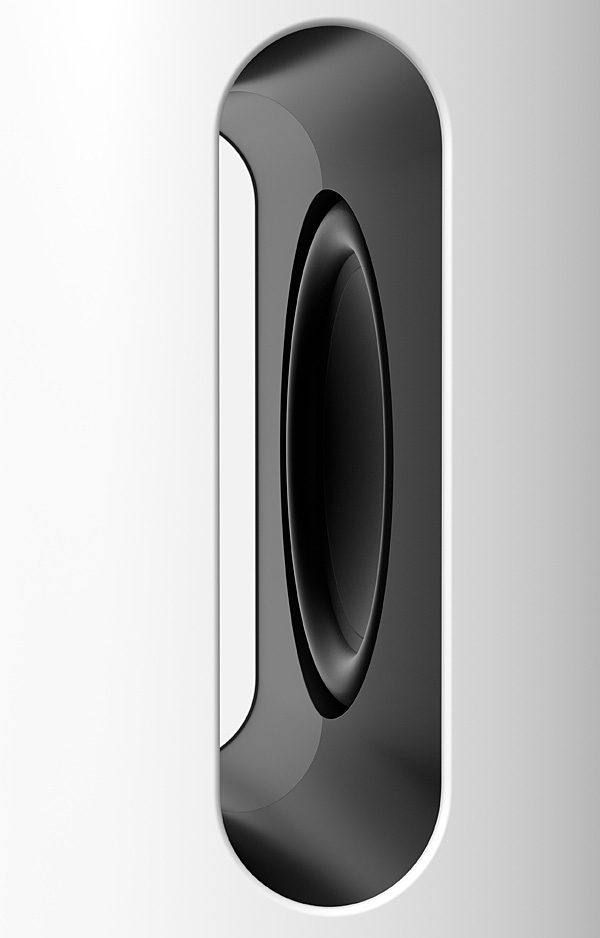
Setup
Setting up the Sub Mini is as easy as any other Sonos product. Make sure your phone is on the same WiFi you want the system on, and the app walks you through the very brief setup process. In very short order, the system will be ready to go. Once you’ve decided where to place the sub, run the Trueplay program to optimize the sound, and that’s all there is. No additional EQ or crossover controls are available.
Performance
Setting up completed, it was time to get to know the Sub Mini. For my first impression, I queued up “I Used to Be Famous” on Netflix. It’s a small movie about a former boy-band star who pairs up with an autistic drummer. I knew the drumming would be a good introduction to the subwoofer; it did not disappoint. In an early scene, a drum circle is featured, and the Sub Mini was up for the challenge. Each impact was sharp and distinct, with a pleasant roundness. Later in the movie, when the unlikely pair debuted at a bar with a complete drum kit, the kick and low toms were solid and tight.
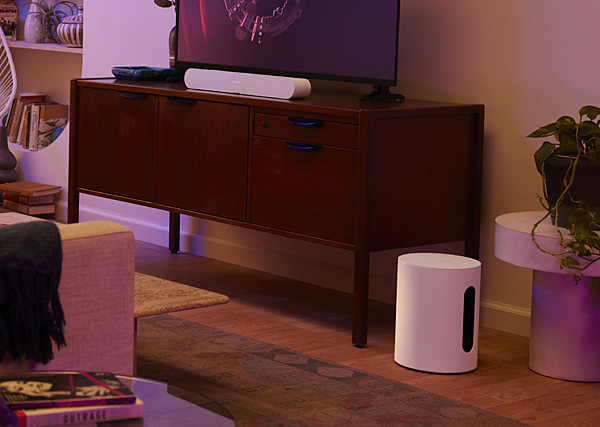
I’m in the midst of binge-watching Chris Pratt in “The Terminal List,” also on Netflix. While using just the Beam soundbar, I never noticed the heartbeat pounding in the opening credits music. But with the Sub Mini bonded to the soundbar, the throbbing beat was bold and impactful. Although I was already well into the series, the Sub Mini inspired me to start it over again — and I’m so glad I did. Even the tense, low-frequency pulses in the prequel scene as the squad lands on the enemy beach sounded much more ominous and threatening. More than just a rumble, the Sub Mini produced a pleasant musical quality; the ensuing battle sequence was handled just as deftly. Explosive impact as gunshots rang out in the underwater caves, followed by grenade discharges, echoed with a massively bass-heavy score.
Switching to listen to music is so simple in the Sonos app. I opened up Spotify to check out the latest from George Ezra. “Dance All Over Me” starts simply enough, but opens up in the chorus. The bassline has a decent amount of punch, but it also maintains a musicality that is impressive for a sub this size. There is a slight gap in the upper bass between the soundbar and the subwoofer—an adjustable crossover would be a welcome addition.
Next up was a hard but important song to listen to: “Cannibal,” a powerful solo release from Marcus Mumford. Throughout most of the song, the low-end is represented just in the lower frequencies of the doubled lead vocal and the deeper notes of his acoustic guitar. But towards the end of the song, the full band kicks in with a massive sound that fills the room with bass guitar, keys, and drums. In this mix, the bass frequencies are so pumped up that it gets a bit boomy for the Mini, but it handles the dynamics without any noticeable distortion.
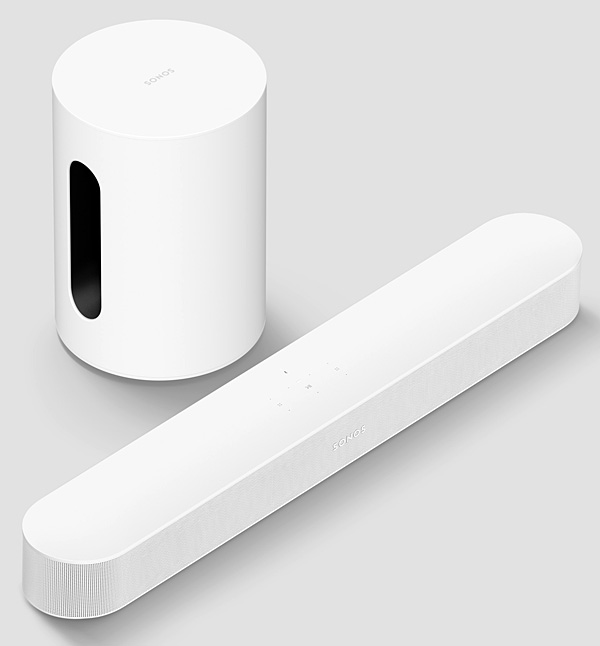
Finally, I dialed up “Irrelevant” by P!nk. From Aaron Sterling’s restrained kick drum that opens the song to the slow buildup to the chorus, the Sub Mini maintained a tight, controlled tone, even as the toms doubled in intensity. Ian Fitchuk’s aggressive bassline is distinct and discernable, even at loud listening volumes. In a full mix like this, the crossover gap isn’t as apparent. In fact, the Sub Mini never calls attention to itself; instead, it just shores up the lower frequencies as needed.
Conclusion
Given the limitations in the Sonos realm for adding a subwoofer, the compact and affordable Sub Mini is a no-brainer addition. It certainly benefits the smaller soundbars, and would even enhance and add depth and range to the bigger Arc. Once you’re committed to Sonos, go all in and add the Sonos Sub Mini.



































